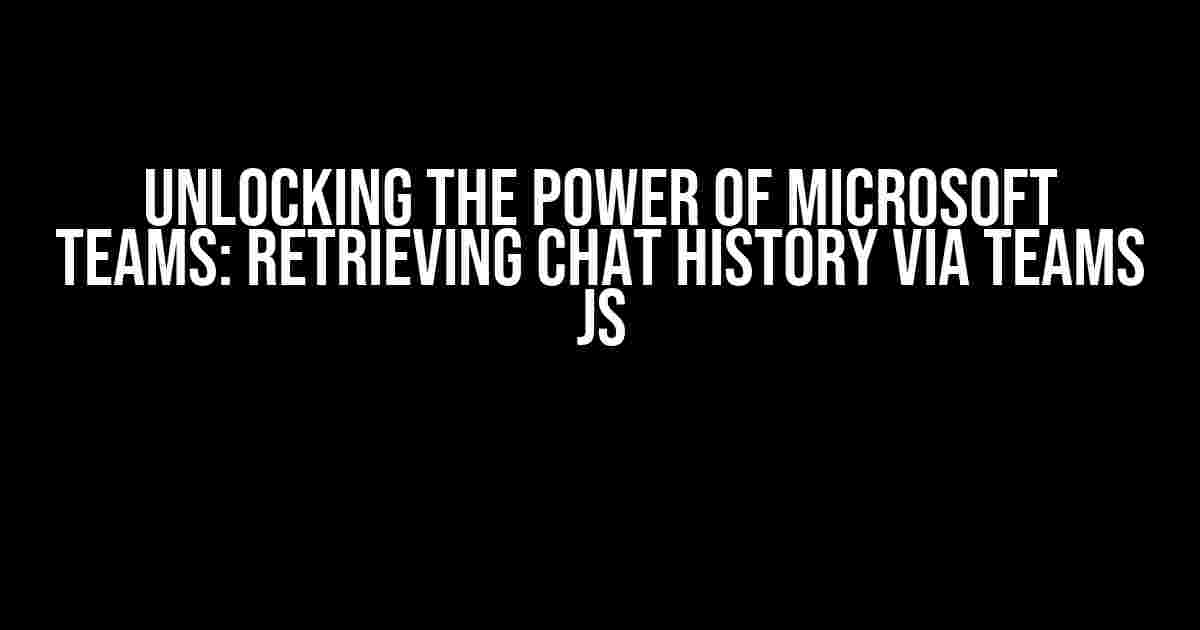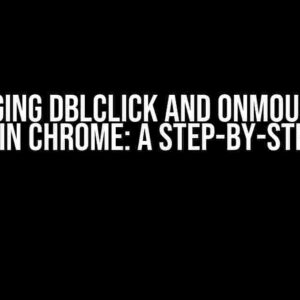As the digital landscape continues to evolve, the way we communicate and collaborate has changed dramatically. Microsoft Teams has emerged as a leading platform for team collaboration, offering a robust set of features to enhance productivity and efficiency. One of the most essential aspects of Teams is its chat functionality, which allows users to converse and share information in real-time. However, have you ever wondered how to access and utilize chat history data? In this comprehensive guide, we’ll explore the world of Teams JS and demonstrate how to retrieve chat history data, unlocking the full potential of Microsoft Teams.
What is Teams JS, and Why Do I Need It?
Teams JS is a Microsoft-provided JavaScript library that enables developers to interact with the Microsoft Teams platform. By leveraging Teams JS, you can create custom applications, integrations, and bots that seamlessly integrate with Teams. With Teams JS, you can access a vast range of Teams data, including chat history, which can be used to create powerful analytics, visualizations, and automated workflows.
The Importance of Chat History Data
Chat history data is a treasure trove of valuable insights, providing a unique window into team communication patterns, sentiment, and behavior. By analyzing chat history, you can:
- Identify knowledge gaps and areas for improvement
- Analyze conversation trends and sentiment
- Automate workflows and notifications
- Enhance team performance and collaboration
Setting Up Teams JS and Azure AD
To get started with retrieving chat history data, you’ll need to set up Teams JS and Azure Active Directory (Azure AD). Follow these steps to get started:
- Register an Azure AD application and grant the necessary permissions for Microsoft Teams
- Install the
@microsoft/teams-jspackage using npm or yarn - Import the Teams JS library in your JavaScript project
- Use the
MicrosoftTeams.authentication.getAccessToken()method to authenticate with Azure AD
import { microsoftTeams } from '@microsoft/teams-js';
// Register your Azure AD application client ID and tenant ID
const clientId = 'your_client_id';
const tenantId = 'your_tenant_id';
// Authenticate with Azure AD
microsoftTeams.authentication.getAccessToken({
clientId: clientId,
tenantId: tenantId,
scopes: ['https://graph.microsoft.com/.default']
})
.then((accessToken) => {
console.log('Access token obtained:', accessToken);
})
.catch((error) => {
console.error('Error obtaining access token:', error);
});
Retrieving Chat History Data using Teams JS
Now that you’ve set up Teams JS and Azure AD, it’s time to dive into retrieving chat history data. You can use the MicrosoftTeams.chats.getChatMessages() method to fetch chat history data.
import { microsoftTeams } from '@microsoft/teams-js';
// Set the chat ID and number of messages to retrieve
const chatId = 'your_chat_id';
const maxMessages = 100;
// Retrieve chat history data
microsoftTeams.chats.getChatMessages(chatId, maxMessages)
.then((messages) => {
console.log('Chat history data:', messages);
})
.catch((error) => {
console.error('Error retrieving chat history data:', error);
});
Understanding Chat History Data Structure
The chat history data returned by the MicrosoftTeams.chats.getChatMessages() method is an array of message objects, each containing the following properties:
| Property | Description |
|---|---|
id |
Unique message ID |
conversationId |
Conversation ID the message belongs to |
chatId |
Chat ID the message belongs to |
messageType |
Message type (e.g., text, file, or sticker) |
text |
Text content of the message |
createdDateTime |
Timestamp of when the message was sent |
from |
Sender details (e.g., user ID, name, and email) |
Practical Applications of Chat History Data
Now that you’ve retrieved chat history data, it’s time to explore the endless possibilities. Here are some practical applications of chat history data:
- Conversation Analytics**: Analyze conversation trends, sentiment, and engagement to optimize team communication.
- Automated Workflows**: Use chat history data to trigger automated workflows, such as task assignments or notifications.
- Knowledge Base**: Create a knowledge base by extracting valuable insights and information from chat history data.
- Custom Integrations**: Integrate chat history data with other Microsoft Teams features, such as channels, meetings, or files.
Conclusion
Retrieving chat history data via Teams JS unlocks a treasure trove of insights and opportunities for automation, analytics, and customization. By following this comprehensive guide, you’ve taken the first step towards harnessing the power of Microsoft Teams. Remember to explore the Teams JS documentation for more advanced functionality and features.
Happy coding, and don’t forget to unlock the full potential of Microsoft Teams!
Frequently Asked Questions
Get the scoop on accessing chat history via Teams JS!
How do I access chat history using Microsoft Teams JS?
You can access chat history using the Microsoft Graph API, specifically the `https://graph.microsoft.com/v1.0/teams/{teamId}/channels/{channelId}/messages` endpoint. You’ll need to authenticate with Azure AD and obtain a valid access token to make the API call.
What permissions do I need to access chat history?
To access chat history, your application needs the `ChannelMessage.Read.All` permission. If you’re building a Teams tab, you’ll also need to request the `TeamsTab.Read.All` permission.
Can I access chat history for a specific chat or channel?
Yes, you can access chat history for a specific chat or channel by specifying the channel ID or chat ID in the API call. For example, `https://graph.microsoft.com/v1.0/teams/{teamId}/channels/{channelId}/messages` returns messages for a specific channel, while `https://graph.microsoft.com/v1.0/teams/{teamId}/channels/{channelId}/chats/{chatId}/messages` returns messages for a specific chat.
How far back can I access chat history?
By default, the Microsoft Graph API returns chat history for the past 30 days. However, you can use the `$filter` query parameter to retrieve messages older than 30 days, up to a maximum of 3 months.
What format does the chat history data come in?
The chat history data is returned in JSON format, with each message represented as a separate object containing properties such as `id`, `body`, `createdDateTime`, and more.


